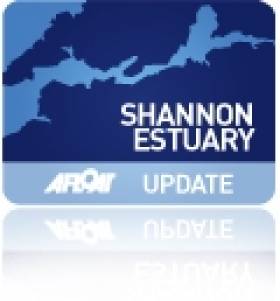Displaying items by tag: SFPC Vision 2041
#NewMaritimeMuseum – As previously reported, Shannon Foynes Port Company's master plan 'Vision 2041' looks forward to the future and soon the past will be explored when a new maritime museum opens next month, writes Jehan Ashmore.
It was at the launch of the masterplan at the Foynes Flying Boat Maritime Museum, where the new museum (opening 14 March) will be incorporated, to trace the rich history of the Shannon Estuary.
As the largest 'navigable' estuary (500km2) in Ireland and one of the deepest waterways in Europe, the museum will not just focus on shipping, but also the geology, personality and mythology of the estuary stretching from Limerick Docks down to Loop Head, marking the mouth of Shannon.
As previously reported, vessels such as the 82,562dwt London 2012, a dry bulk-carrier (Length: 229m X Beam: 32m X Draft: 14m) had docked at the Aughinish Alumina jetty last month.The port, which is Ireland largest bulk port company can handle larger vessels up to 200,000dwt, however under Vision 2041, the Shannon estuary is to cater for the World's largest container ships as the port is strategically located as a potential hub-port in Western Europe and creation of a 'Ocean Energy Hub'.
Its prime position is to take advantage of the new 'post-Panamax' sized super container ships and tankers under construction following the completion of the enlarged Central American canal linking the huge Asian market, notably from China and or via North America and onwards to Europe.
As these developments look to the future prospects of the estuary's ports, the past will not be forgotten as the flying boat museum with its replica aircraft based in Foynes, will have a new floor dedicated to exhibits. The diversity of topics on display in the maritime museum are listed below.
• The charts and maps of the river from the time of Ptolemy.
• The geology, tides and weather of the Shannon
• The pilots who raced in their rowing boats to be the first to guide large sailing ships up the estuary
• The dockworkers loading and unloading a vast range of cargo from ocean-going ships
• The "Spring-Rice Set" —the O'Briens, De Veres and Spring Rices, who owned large tracts of land on the shores of the river but who were actively concerned in the welfare of the less fortunate people around them
• The amazing record of ships on the river left to us by Murrogh O'Brien in the form of paintings and charts
• Different types of ships and boats used on the river
• The development of Foynes Port
• Navigation of the river including the many lighthouses that guided mariners up the river
• The tragic story of the Colleen Bawn
• The story of Transportation and emigration on the river.
• Tait's manufacture and export of uniforms to the American confederates during the Civil War.
• Display with Met Maps and audio visual on weather conditions.
• Story of the Windsor Castle Ghost Ship, sailed up the Shannon in 1843.
• Audio Visual on life on the River Shannon.
The maritime museum will be opened to the public from 14 March, 9am-5pm (visitors should try and arrive an hour before closing). For further details visit: www.flyingboatmuseum.com/
Masterplan Sets Out 30 Year Vision for Ports on Shannon Estuary
#SHANNON PORTS- A draft masterplan Vision 2041, to develop port infrastructure and services for the Shannon Estuary over the next three decades, has been published by Shannon Foynes Port Company (SFPC).
The masterplan for Ireland's second largest port which has six terminals along the 500sq km navigable estuary, has specifically targeted growth and expansion options. Also identified are capacity and associated port infrastructure requirements, where SFPC has called for improved road and rail access.
In addition the masterplan is to take into consideration of non-core assets facilities at Foynes Port and Limerick Docks which consists of the single (Ted Russell) Dock basin.
Vision 2041 recognises the strategic need of the estuary to be in position to ensure future capability in handling larger trade volumes efficiently and competitively when the opportunities arise.
The masterplan has concentrated in identifying three key major objectives:
Significant expansion and infrastructural development in the deepwater Port of Foynes
Promoting non-core assets in Limerick Docks for alternative port / non port related activities
Managing the natural attributes of the estuary and its destination as an Ocean Energy Hub
The objectives of Vision 2041 are to realise the economic potential of the natural resource along the Shannon Estuary and developing positive promotion of the ports as a strategic economic driver for the Mid-West Region.
Copies of the SFPC Vision 2014 masterplan can be downloaded from clicking this LINK or alternatively a digital copy can be requested by contacting the Masterplan Team at 069 73100. The deadline for written submissions concerning the draft Masterplan is up to and incl. 1st February, see website for postal address and email details.

























































